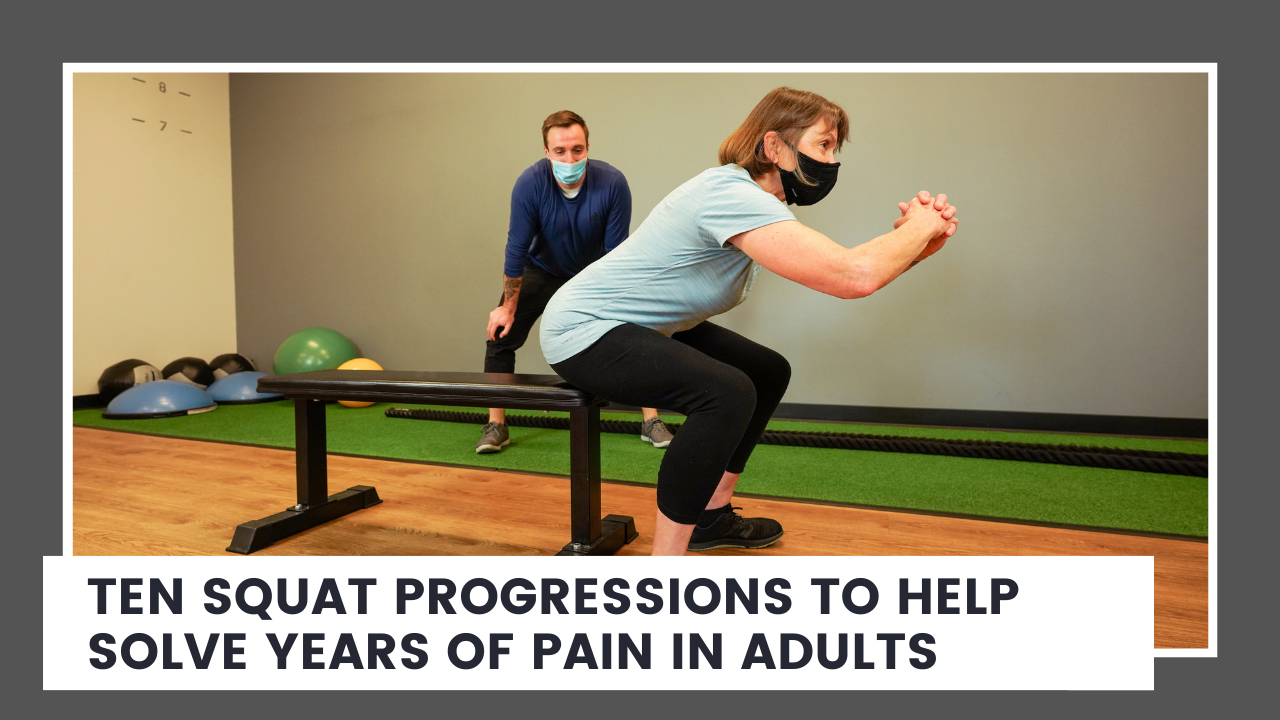Ten Squat Progressions To Help Solve Years Of Joint Pain
The following ten squat progressions are what I have been using in my clinicfor the last 10 years to help solve years of joint pain in adults from the age of 25...all the way to 83! Learning to limit the impact that goes through out joints with better movement and increased strength is the best treatment for joint pain and helps adults keep active, strong, and doing what they love as they get older.
When using squats to treat joint pain, it's vital that we find the right starting point and work up from there. In this article I've included ten squat progressions to help ANY ability level build confidence in the squat movement.
1. Sit To Stand
The sit to stand is the place to start for anyone with knee or back pain, limited mobility, or limited experience with the squat. This is a safe a effective way to build confidence in our squat before moving to full body weight
2. The Box Squat
The box squat is a safe and effective way to learn good squat patterning. Placing a box/chair/couch/etc. behind you allows you to practice and build confidence in the squat in a safe environment.
3. The Air Squat
Once you feel comfortable with the box squat you're ready to move onto the air squat. Be sure to control your depth to keep good spinal positioning.
4. Tempo Squat
We can further ingrain our squat patterning by slowing the movement down. Use a 3-2-1 Tempo. 3 Seconds down, 2 second hold at the bottom, and 1 second to return to standing.
5. One and One Half Squat
The One and One Half Squat is a great way to increase the 'time under tension' for our squat. This will help you further ingrain the movement pattern and start to build strength in the movement.
6. Banded Air Squat
Once you feel confident in the squat movement we can start to add resistance. Place a band around your knees, press your knees out to engage our glute med and hip complex, and perform the airsquat.
7. Air Squat and Hold
Holding the squat at the bottom of our movement is a great way to further build strength and confidence in the movement. This one is harder than it looks...give it a try!
8. Goblet Squat
By now you should be feeling pretty confident with how to perform the squat movement. Now it's safe to add weight and really start building strength.
9. Single Arm Goblet Squat
Start to get into some functional core strengthening with single arm goblet squats. Same as the goblet squat, but shifting the weight to one side forcing our core to engage to ‘balance’ us out.
10. Single Arm Goblet Squat To Press
We can even turn the squat into a full body, functional exercise. This can help you build strength in both the lower and upper body, build core strength, and improvement movement coordination for less stress on your joints.
BONUS: Barbell Back Squats
I truly believe the barbell is the BEST tool for adults 40+ to build the strength and confidence to live active, and happy lives. I strongly encourage you to get a coach and learn how to squat with a barbell. The benefits are endless.
Strength training can be intimidating if you're in pain or new to exercising. My goal is to make it more approachable by providing step-by-step instructions to help you build confidence in each movement. I hope the ten squat progressions we covered here help you get started on your strength journey...no matter your age or ability level.
Don't forget to download our free guide to learn more ways to build strength and solve joint pain once and for all.



